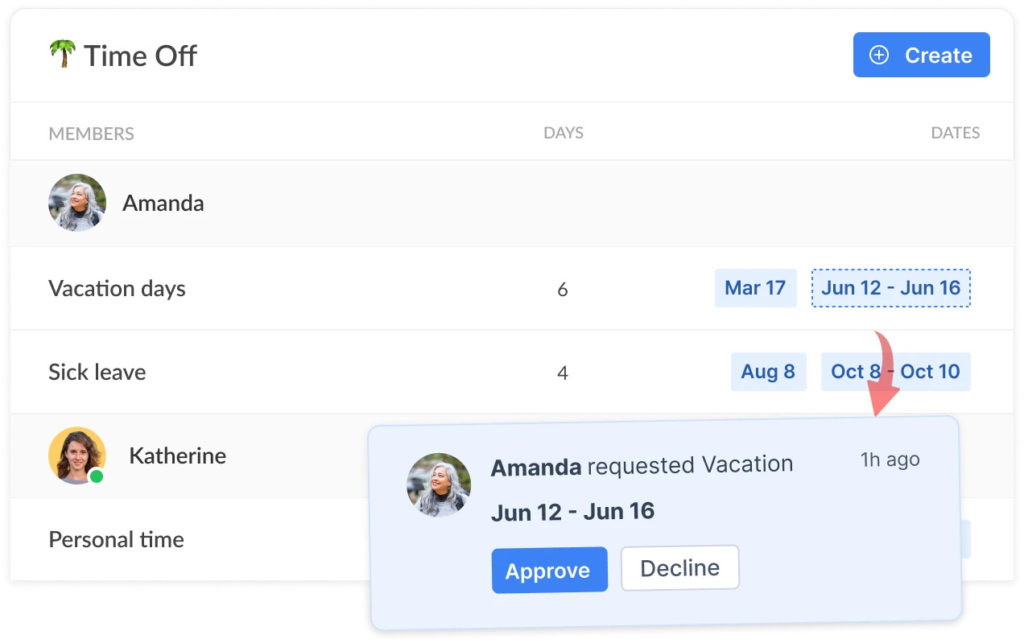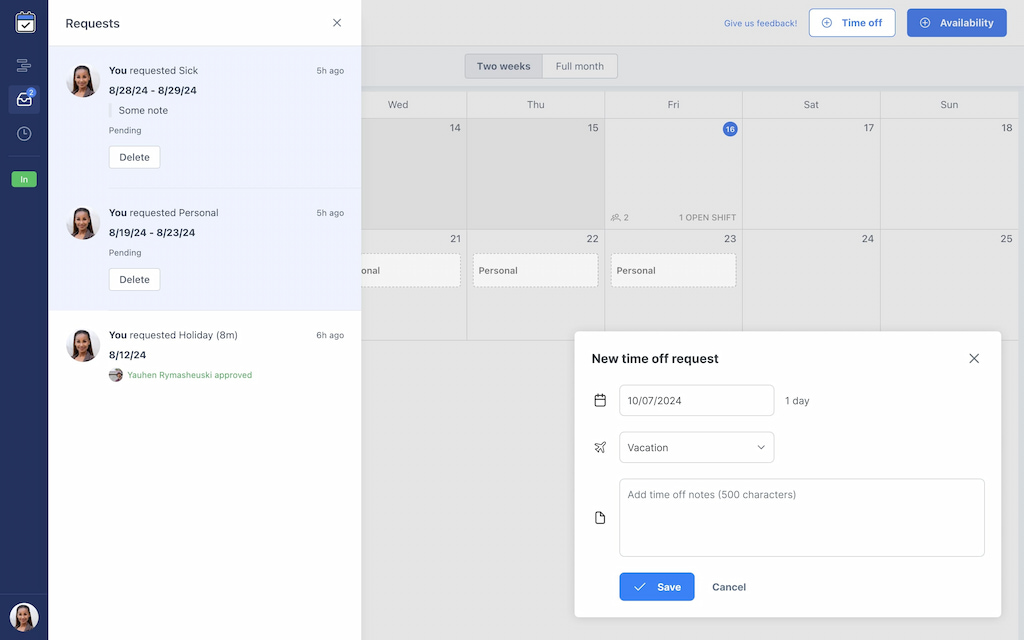Manual time-off tracking leads to confusion, errors, and team friction. That’s where simplified, automated, and transparent systems come in—they eliminate these headaches by ensuring fair approvals, accurate records, and stronger workforce planning. This time-off management guide dives into the “what,” “why,” and “how,” with step-by-step advice on how to schedule workers without spreadsheets —and how to improve accuracy, save time, and increase employee satisfaction.
❌ Why Spreadsheet Time-Off Trackers Fail
Spreadsheets were never built to manage dynamic team operations:
- 📁 Data fragmentation: Multiple versions, lost files, inconsistent updates
- ⚠️ Hidden conflicts: Double-booked PTO or coverage gaps
- ⏳ Approval bottlenecks: Email chains delay decisions and create silos
- 🧾 Mistakes in reporting: Manual entries lead to payroll errors
“We missed three overlapping vacation requests last quarter—and nobody knew until it was too late.”
The bigger your team or the more complex your operation, the more these problems compound.
✅ What A Simplified System Looks Like
A transparent, centralized time-off system brings structure and clarity:
- 📋 One dashboard for all requests and approvals
- 🔔 Automated alerts for overlapping requests and coverage conflicts
- 📏 Built-in policy enforcement to match your PTO rules
- 📊 Real-time tracking and history for audits or payroll review
- 📱 Mobile-friendly interface for frontline accessibility
🟢 This isn’t just about ditching spreadsheets—it’s about creating a real-time, high-trust system. Teams using automated PTO systems report:
- Up to 40% faster approval times
- Fewer conflicts around overlapping requests
🛠 Core Features of Efficient PTO Tools
✨ Must-have features
- ✅ Request & approval workflows: Track who asked, who approved, and when
- ⚠️ Conflict detection: Warns when too many people are off
- 📅 Calendar sync: Syncs with Google, Outlook, or Slack
🚀 Advanced features
- 📈 Accrual logic: Automatically calculates earned PTO balances
- 📊 Reporting dashboards: Trends, requests per department, usage by team
- 🔌 Integrations: Connect with payroll, HR tools, and shift scheduling (e.g., Shifts by Everhour)
- 🧩 Role-based permissions: Managers see their team only; execs see org-wide

🛣 Step-by-Step: From Sheets to Automated PTO
Step 1 – Audit your current process
Ask these questions:
- How do employees currently request PTO?
- Who approves it, and how is that tracked?
- How is it reported or synced to payroll?
- What issues have occurred in the past 90 days?
Step 2 – Define PTO policy & rules
Before automating, clarify policies:
- Accrual rates (e.g., per month or per pay period)
- Blackout dates and mandatory team coverage rules
- Approval hierarchy (line manager, HR, etc.)
- Required lead time before requests are valid
Step 3 – Choose the right platform
- Starter setup: Google Forms + Calendar + Sheet
- Recommended: Shifts by Everhour – integrates PTO with shift scheduling, mobile-friendly, transparent for all users
- Look for tools with preset rules, alerts, and visibility controls. For example, Shifts by Everhour offers customizable PTO policies, mobile accessibility, and conflict prevention baked in—ideal for scaling teams.

Step 4 – Pilot with one team
Start with a single department:
- Enable the tool with your policies pre-set
- Show the mobile request/approve experience
- Review the audit trail and automatic tracking features
Step 5 – Train and standardize
- Host short training sessions or share explainer videos
- Distribute cheat-sheets for employees and managers
- Include PTO rules and request instructions in onboarding
Step 6 – Monitor, measure, improve
- Track average approval time, request volume, and denial rate
- Identify where delays or bottlenecks exist
- Forecast future staffing gaps with better accuracy
- Quantify time savings for admins and managers
- Review conflict alerts and missed shift incidents
Survey staff: is it easier, clearer, and more transparent? You can use a quick poll in Slack or a 2-minute Google Form to gather actionable insights.
📈 Tangible Payoffs of Automation
| Challenge | Spreadsheet-driven | Automated PTO system |
|---|---|---|
| Approval delays | Common, slow follow-ups | Instant alerts, streamlined flows |
| Coverage gaps | Missed due to manual review | Auto-conflict detection |
| Accrual miscalculations | Manual errors, employee disputes | Built-in logic, transparent records |
| Compliance risk | Incomplete audit trail | Timestamped history & reports |
| Admin burden | High—lots of chasing | Self-serve process, no bottlenecks |
Real-time visibility removes guesswork. Less time spent managing PTO means more time improving operations.
🙋 FAQ: Common Time-Off Management Concerns & Solutions
“We don’t have a budget for another tool.”
Manual mistakes cost more long-term, in payroll errors, missed coverage, and team friction. Many tools, including Shifts by Everhour, offer low-cost or freemium plans.
“Our team isn’t tech-savvy.”
Modern PTO tools are as easy as submitting a vacation request on your phone—tap, send, done.
“We need flexibility—will it be too rigid?”
Custom rule engines allow overrides. Managers can approve special exceptions manually if needed.
“Will this confuse people used to spreadsheets?”
Start with a hybrid phase—run both in parallel for 2 weeks. Use this time to compare response times, error frequency, and team satisfaction between systems to gauge effectiveness before fully transitioning. When teams see the benefits firsthand, adoption follows quickly.
“We only have 8–10 people—is it worth it?”
Yes. Small teams are more sensitive to absences. One missed shift can cause a chain reaction.
🚀 Time-Off Management: Your Action Plan
- 🗺️ Map out how PTO is currently requested, approved, and tracked
- 📜 Clarify your policies, accrual logic, and visibility needs
- 🧪 Pilot Shifts by Everhour for PTO + shift coverage in one platform
- 🧠 Train teams and go live with a test group
- 📉 Measure savings: admin time, fewer conflicts, better employee trust
🔚 Final Thoughts: Ditch Spreadsheets, Build Clarity
Teams today need fairness, transparency, and automation to reduce scheduling stress and improve trust. Spreadsheets were a starting point—not a long-term solution. Start today and streamline your time-off process within a week—your team will thank you. Move from manual to intelligent scheduling for hourly employees!
Start your free trial today with Shifts by Everhour or download our time-off management template—and take the first step toward simpler, smarter time-off planning.

